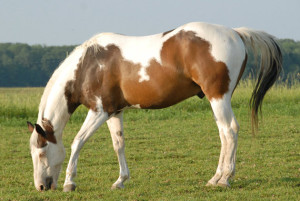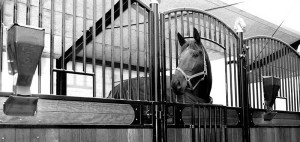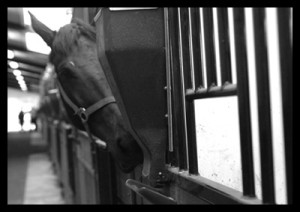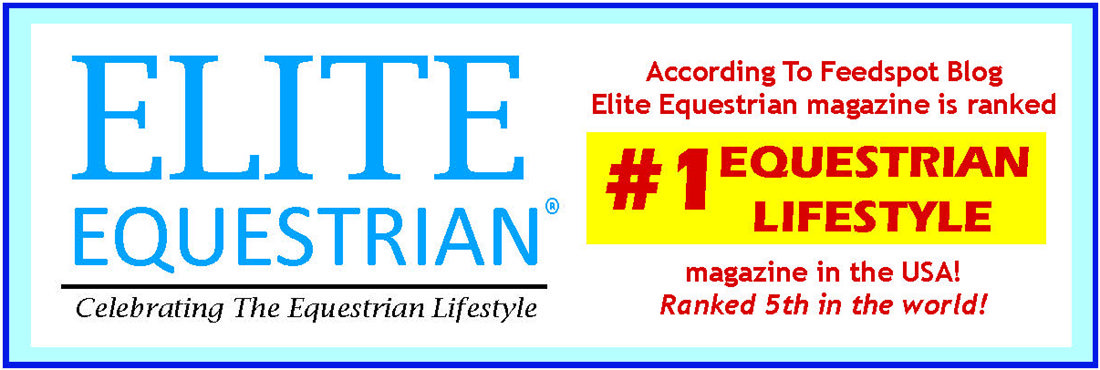
Automatic feeders – worth more than money.
When weighing the benefits for the investment in an automatic feeder, money is a big consideration. The initial investment of USD 400,- to USD 1500,- per feeder can be enough for a horse owner to stop the research right there. While it is true that some automatic feeders saves the owner from 20% to 40% in feed annually, depending on how often their horses are fed manually, there is much more to this calculation than money and time. In this simple piece of math below, we are only looking at the feed savings. Time and labor as well as money spent on vets and medications for ulcers and colic have not been calculated. In this example we expect 8 lbs. of feed daily at a cost of USD 20.00 per 50 lbs. bag.
Since it has been proven that trickle feeding helps defend against colic and has been found to cure ulcers in many cases, the cost associated with these disorders should also be taken into consideration. Ulcer medication is expensive but only helps alleviate the pain associated with ulcers by reducing the amount of hydrochloric acid naturally produced by the horse. Ulcer treatments can cost up to USD 1000.00 for a 28 day dose package with additional maintenance prevention running at USD 5.00 per day. Colic, which is the number one killer of horses, presents a much larger investment anytime surgery is needed or when the vet is called to the barn.
There are approximately 97000 cases of colic a year and estimates for ulcers show that more than 80% of performance horses suffer from this affliction. To defend against these expensive and debilitating disorders using an automatic feeder, is a smart investment. Also worth mentioning is the widespread problem with stall vices triggered in many cases by boredom that leads to additional costs due to destructive behaviors and injuries suffered by the horse.
To understand why the consideration to invest in an automatic feeder goes way beyond the savings in time and feed and should include at the very least some of the costs associated with colic and ulcers mentioned above, we need to first realize that horses are foragers and understand what that means when looking at their digestive systems and natural instincts.
Horses are hindgut herbivores and were designed to be foragers. They evolved in Asia and the Middle East in arid environments and were forced to forage large areas in order to get enough to eat. Horses have a small stomach representing only 7% of their digestive tract and therefore they need to graze almost continuously. Unlike humans, horses do not require much sleep, and grazing periods are rarely separated by more than two to three hours of non-eating behavior. As man domesticated the species, confinement was implemented and the whole way of life changed for the horse. Horses are now fed at man’s convenience which led to a change from a continuous forager to a meal eater whereby the majority of the dietary energy is derived from a few large daily servings of grains. Providing a natural “grazing environment” in the stall has previously not been possible.
Why do horses colic?
Most of the time, colic is due to feeding mismanagement resulting from a poor understanding of the horses digestive tract. To reduce colic we must first understand all the contributing factors that have a role in causing colic. The word colic simply refers to abdominal pain. It covers a multitude of abdominal and intestinal problems, ranging from simple excess gas to severe torsion or twisting of the intestines. It can also include stomach ulcers, uterine pain and pain associated with disease in organs of the abdomen. Unfortunately many of these factors are due to man’s mismanagement of horses.
Although there are many different kinds of colic and many different triggers for colic, experts agree that the number one cause for colic is a direct result of diet and is often preventable.
Due to the changes in availability of quality hay and pasture grazing, as well as the need for confinement in stalls and the performance demands of our horses, we are depending on grain and other types of sweet feed for the majority of the nutritional value our horses need.
This can often lead to hindgut acidosis, a lower pH and increased acidity, a change in the microbial balance compromising the mucosal lining in the gut potentially leading to food blockages and induced colic. We often have no other choice for feeding our horses available however and because it is impossible to manually feed these types of feed in a manner that allows our horses to digest them properly, we have introduced an increase in colic and ulcers to our horses. The exact sequence is unknown but significant research shows a direct link between how we feed feeds high in simple carbohydrates and colic. With the introduction of automatic feeders, you are now able to take these 2-3 large portions of feed and divide them into 70-80 smaller portions fed throughout the day and night thus reducing the risk of colic considerably.
A typical scenario in the barn.
Its 5PM and up and down the aisle of the horse barn, the nickering, rumbling, kicking and pawing begins. What is the cause of the excitement? Nothing more than the sound of a scoop digging into a bin of grains. The sound that tips off every equine resident that it is dinnertime. Hay seldom gets this sort of attention. It is grains that horses really relish.
Just because horses love grain doesn’t mean it is an essential part of their diet. In a wild state, they encounter grains only as an occasional plant seed head and certainly not in the volumes found in their feed buckets in a domestic scenario. While their teeth can grind seeds quite efficiently, their digestive system is poorly equipped to deal with the low-fiber, high-carbohydrate wallop that grain delivers, thus the higher incidence of colic among grain-fed horses compared with those fed only forages. As most of us know, the intake of an excess quantity of any type of grain can result in dire consequences, including life-threatening colic and founder.
Unfortunately, equids have no dietary wisdom when it comes to grain, and given the opportunity to gorge themselves, if given the chance, they can conceivably eat themselves to death. Because of this, grain should never be fed free-choice or left so that it is accessible to horses outside of their allotted amount at mealtimes. And except in some exceptional circumstances, the grain portion should never be more than 50%, by weight, of a horse’s total daily ration. It might not need be fed at all, in fact, unless you wish to supplement the energy or nutrient demands of your horses beyond what their forage provides. Many pleasure horses, especially those that are “easy keepers”, do very nicely without the addition of grain to their diets.
Grains in the natural state supply very little in the way of vitamins whereas commercial horse feeds are formulated to provide the right amounts of vitamins and minerals to the individual horse when fed properly. To take advantage of all the benefits your feed offers and ensure proper nutritional uptake, horses must be fed many small portions throughout the day and night. As we know, the horse’s digestive system is not equipped to deal with large portions in one sitting and what happens when horses are being exposed to these large portions is that most of that feed is simply not digested and can end up exposing the horse to serious digestive risks. In order for feed to be digested in the smaller and larger intestines, the feed must first be broken down. This process starts in the horse’s mouth as the feed is ground down into smaller particles, mixed with saliva and then swallowed and exposed to the hydrochloric acid in the stomach. Saliva is an important part of this process which is why horses need many small portions to continually produce adequate amounts of saliva. Saliva not only helps with the passage of food through the gut, it also acts as a buffering solution to help maintain proper gut pH. This is an integral part of counteracting against the acidic gastric fluids in the stomach, an important factor for preventing ulcers. Another factor to take into consideration when feeding our horses, is the size of the stomach. The stomach holds only 3-5 gallons and most feeds pass through the stomach rapidly, often entering the small intestines within 15-30 minutes of being eaten. Grain is digested more quickly than hay which is another reason why feeding your grain or commercially formulated feed needs more care than simply dumping a scoop of feed into the bucket.
Understanding how horses digest their feed and realizing how unique the GI Tract of a horse is, how delicately and complex this system functions will allow us to improve the health of our horses. These man-made problems can be avoided by better understanding our horse’s behaviors and instincts and re-introducing them to the natural feeding cycles their delicate systems demand.
When using an automatic feeder, that 5PM anxiety is no longer evident in the barn. In fact you will notice a complete transformation in the environment in the barn within 48 hours of using automatic feeders. People who today utilize automatic feeders as part of their feeding management report that their horses are calmer, are lying down in their stalls more and display a new and improved behavior, including improved performance and energy. The stress a horse experiences when feed is not available consistently, releases cortisol which in turn leads to an increase in insulin. This can then leads to fat storage which increases the risk for laminitis. It’s a vicious cycle but one that can easily be broken through proper feeding management. Additionally, users of automatic feeders report large reductions in manure output, due to the fact that the horses’ digestive system now functions properly. The reduction in manure and savings in stall bedding, not only saves money and time but also helps reduce the environmental footprint our animals leave behind.
How can I take this knowledge and apply it in my barn?
Now that we understand how the GI Tract of a grazing animal works, we can attempt to mimic what our horses would do if left in the wild. While it is not always possible for us to offer our horses their preferred environment due to lack of pasture lands and due to the performance and nutritional requirements of our horses, we can take our knowledge and utilize existing technologies offered by automatic feeders which will allow us to keep our horses in a low risk environment, even when we are unable to provide them their natural habitat. It is simply not possible to offer this feeding schedule manually.
While we improve the well being and performance of our horses through the use of automatic feeders, we can simultaneously save money by reducing the feed we waste through overfeeding and undigested feed. When reducing feed you also reduce the waste produced by our horses, thus reducing the environmental impact our horses leave behind.
The simplicity of feeding many smaller portions throughout the day and night – 70-80 portions over 10-12 feedings – mimics what horses would do when given the choice. It is the natural way a horse would eat and supports their delicate digestive system. This technology has been proven on markets around the world for years and has gained universal acceptance as the proper way to feed our horses when feeding grains and commercial feeds. Leading horse men and women attest that automatic feeders have been the single biggest game changer for their success and health of their horses. With this technology you know not only what, when and how much your horse is getting, you know he is getting what he needs and more importantly gets it how he needs it. Nothing can be more important than to improve the health and wellbeing of our horses when we have the opportunity to do so. We have an opportunity to do the simplest of things, to re-introduce proper feeding to our horses by utilizing available technology and reduce the exposure to the lethal and wasteful practices currently in use.
It is time that we start reducing our horse’s exposure to high risk diseases such as colic and founding and stop the ulcer epidemic.
The investment in automatic feeders is not about money alone. It is not about convenience. Automatic feeders are more than a delivery device that dispenses feed on a set schedule. They represent a health care product that veterinarians and nutritionists from around the world supports. They allow the horse owner to use the already scientifically balanced commercial feeds as health food that prevents and in many cases cure some of the most common digestive disorders. Our horses depend on us for everything they need and as horse owners we want the very best for our horses and we want them to have a long, healthy and happy life. We need to provide them with the best foundation we can under the circumstances we face. In return our horses will give us priceless experiences and adventures. Knowing that our horses are entertained with small servings of feed in a manner that is healthy, even when we are not around to do so, gives us peace of mind knowing that we are doing the very best we can for our animals.
Due to lack of pasture lands and quality hay as well as the fact that our horses often need more than grass and hay to be able to perform at the level we ask them to perform at, commercial feeds and grains are here to stay. For better or worse, these commercial feeds are a part of the life of the domesticated horse. The choices of feed available have been formulated to introduce the proper nutritional values for the individual horse when fed in the proper manner only. Feeding 2-3 large portions daily, which is the most common way to feed commercial feeds, is not only wasteful but dangerous to the life and wellbeing of our horses. However, when fed in a manner that supports the digestive system of the horse, these feeds represent a tremendous value as you will now be able to maximize the benefits these feeds have been designed to offer.
Implementing something as simple as a feeding schedule that allows your horse to “graze” 24 hours a day, you allow your horse to be…..well a horse. When the return on your investment in an automatic feeder is so overwhelmingly sound, there can be no excuse not to save our horses from pain and ourselves from potential heartache. Maximize your investment in commercial feeds by feeding many small meals throughout the day and night and use the feed not only as nutrition but as a way to improve the health, performance and wellbeing of your horse and introduce a more natural environment in the barn. As caring horse people, we must recognize the importance of management and prevention. With the availability of automatic feeders for as little as USD 399.00, saving thousands of dollars in feed, time and healthcare expenses has never been easier. Help save the environment at the same time is just a bonus.
Give automatic feeders a second look, or your first look and when doing the math, ask how much the health and well being of your horse is worth.



